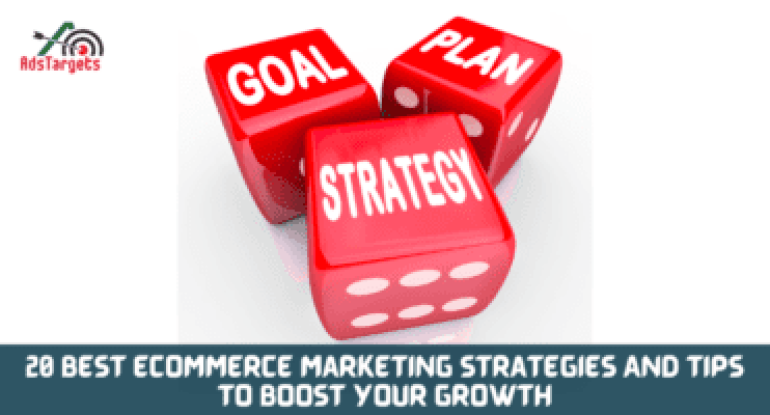Updated 15/05/2025
There is no doubt that the only thing that is fashion in the world of business is that every business is taking space online to market its brand.
That said, every online store needs some form of eCommerce marketing strategy to stay in the hotspot online as the Internet has become a fierce ground for competitors.
Without eCommerce marketing strategies, a marketer is nowhere close to attracting buyers to their online store.
This guide will take you through refined, tested, and trusted eCommerce marketing strategies that are pulling in dollars for all the successful marketers in your industry.
Table of Contents
ToggleEffective Ecommerce Marketing Strategies that Matter to Advertisers Now
#1. Join them if you can’t defeat them
Not many businesses can compete or stay on par with industry leaders like Amazon in sales. You might eventually outsell Amazon, though if you stay close, to their eCommerce marketing strategies and begin to leverage them.
Amazon, like many other successful brands, holds a remarkable stranglehold on the online retail market and it takes more than launching your business online to outrank them. It is in your interest to have some stuff flowing through Amazon, Rakuten, eBay, and other marketplaces until some remarkable changes occur.
Partnering, at least in part, with one of these web design eCommerce powerhouses and whatever additional platforms you can find to maximize your market reach. As soon as you build your brand on one of these websites, visitors will come to your website naturally.
#2. Maintain a broad and relevant Network
Help users remember you by following up or checking in, whether they are clients, partners, or anybody else.
The world of eCommerce marketing revolves around connections and networking, so whenever your business is falling behind or you need a boost, you should have an abundance of warm bodies to turn to for help.
Don’t cut corners on marketing; inform your consumers of restocked items and seasonal promotions.
#3. Establish your brand
Branding is crucial when it comes to getting people to notice, identify, and frequent your store. Your social media marketing activities, your buying process, your customer service, in other words, everything should offer a brand experience to your customers.
Any retail company’s ultimate goal is to become well-known, and the way to that path is to first define your identity and values before combining them into an immediately identifiable brand for your customers.
#4. Leverage shoppable videos
Leverage shoppable videos to showcase the brand’s products and enable users to shop for the products featured in the videos with real-time purchasing power.
#5. Mobile-optimized for mCommerce
Shoppers get to shop quickly and seamlessly as they watch the videos with tools like a sidebar that facilitate queries, reviews, shopping, and other information in real time.
Vertical video is no more a fashion but a massively accepted format for consuming content online. Yearly, the amount of video being viewed increases by a staggering 100%, and mobile devices account for 75% of all video consumption.
Also, 92% of mobile video content viewers share what they see, making portrait videos an unbeatable tool for communication in your eCommerce marketing strategies toolbox.
Commercial transactions carried out electronically by mobile phone fall into the category of mCommerce (Mobile Commerce) and if your branding, marketing, and product displaying are mobile-friendly, you are just on the right path to reaping massive traffic.
#6. Market to People at Every Stage of the Funnel
This works well if you understand the habits of your target audience. Your marketing funnel offers more value to your marketing strategy when you know your customers then you can make informed decisions to improve the customer experience as they move through the funnel.
Holding the hands of potential buyers at every stage of the funnel motivates them and keeps them in line till they get to the conversion point of your funnel.
Note that every marketing funnel is unique and should be designed based on how customers buy, not how you wish to sell.
Combining quantitative and qualitative data will help you understand how real consumer shop and behave on your site, so you can optimize your marketing funnel for the customer journey and improve conversions.
A marketing funnel has a series of stages to guide potential customers through the customer journey. This tool helps marketing teams strategize and measure efforts to attract, engage, and convert potential customers through content and other marketing materials, like landing pages and ads.
The funnel is divided into the following stage:
#1. Awareness
#2. Interest
#3. Desire
#4. Action
But you can simplify the customer funnel into a three-stage model:
#1. Top of the funnel (TOFU)__ awareness
#2. Middle of the funnel (MOFU)__consideration
#3. Bottom of the funnel (BOFU)__ conversion
#7. Encourage customers to return

When it comes to marketing, it’s comparably easy to get new customers in the door, but getting them to return is a challenge that requires you to put in deliberate efforts.
Every business needs a good dose of new and returning customers to their store, repeat customers give marketers the biggest return on their investment.
Not only do they spend more money in your store, but they may be more likely to recommend your brand to others.
#8. Leverage Influencer Marketing
Influencer marketing has paid its dues and earned its place as a key marketing platform for eCommerce brands due to its impressive ROI, strategic targeting of online audiences, and high influencer engagement rates.
Brands can achieve their objectives with influencer marketing by leveraging the credibility of influencers via sponsored endorsements.
Indeed, it’s one of the most successful marketing innovations for eCommerce brands, big or small. Many eCommerce brands have successfully launched their brands by partnering with influencers, just like these familiar names: Glossier, Audible and Naked Juice.
#9. Show Trendy Products and Content
Your website is the display window for your business. To keep your customers engaged, you need to stay up to date by displaying what is the need of the hour.
Displaying outdated products and content in your display will not only increases the bounce rate but also affects the brand image in the long run.
#10. Display Personalized Content
Buyers get more on the ball every year and play to control their choices, and it’s not always easy to grab their attention.
That’s a big reason the web is moving toward improving levels of personalized content.
When a website runs tests, repeats on pages, and shows different experiences to distinctive visitors, there is a better chance to engage the user.
The passive homepage that gets updated once a year is a thing of the past.
For a great example of personalization in action, check out how Optimizely utilizes personalized content to offer a unique experience based on the knowledge that a user is a Microsoft customer.
The version utilizing content personalization is more inviting, more informative, and more likely to motivate someone to start using the service.
#11. Be Very Clear and About What You Are Selling
What if you wanted to buy a software package but found the one you preferred had ten steps to install and lengthy instructions in the manual on learning and operating the program?
What you should realize is that the brain craves simplicity of content.
Simplicity equals clarity. We think it shouldn’t take much effort for the prospect to discern what you are selling. Simple will always beat out complicated any day.
Imagine seeing a display of 30 different homemade jams at a farmer’s market. Which will you go for? Or will you just keep walking?
What if there were only 3 flavors, would you stop and decide to purchase one or two? Too much comparison overtaxes our brains and buyers don’t like it.
Now think about a solution that might have two steps versus the twelve steps. Remember in our time-starved life, the less time we have to commit, the better.
In the world of sales, simplicity sells.
#12. Use A+ Content for product description
Convincing product descriptions are one of the most vital tools that should be found in the eCommerce marketing strategies toolbox.
With A+ content, you can add value to your product detail page and create defined incentives to buy.
The product description is the internet equivalent of a sales pitch. You have to be very creative and precise at the same time. By utilizing A+ content you can optimize the product description.
#13. Use High quality and Appealing Images
When having an eCommerce store, the first thing you must take care of is how you present yourself in the eyes of the customer. Users are drawn to high-quality visuals and a strong, trusted brand.
If users like the product images, and if the descriptions are informative and personalized for them, they are more likely to be converted into customers.
Since your customer does not have the luxury to see the products in real-time, your image is the only thing that will do the job, let it do the job properly. You need to offer at least multiple high-definition images from different angles.
#14. Work on Search Engine Optimisation (SEO)
Search engine optimization (SEO) is one of the most important eCommerce marketing strategies for any business operating online to pursue success.
From multinational corporations through small businesses down to startups, a good SEO strategy will increase online visibility. This means more users searching for your services and visiting your landing pages.
The exact value of SEO ROI can be hard to quantify. Marketing experts agree, though, that every position you gain in SEO rankings is a boost in potential income.
To optimize your eCommerce store, you have to boost your presence on search engines. This means utilizing high-volume keywords in the page title and meta description. This is a long-term investment and will offer you benefits in the long run.
#15. Make your website mobile-friendly
Buyers, especially millennials and Gen Zers, favor the convenience and the great offers and discounts associated more with transacting online than visiting a brick-and-mortar store.
It’s these groups that are driving eCommerce retailers to be strategic with their website design. It’s not enough to have a good eCommerce site: your site must be optimized for mobile shopping too.
#16. Adjust to the times
Have you ever come across websites that look outdated, old, and just plain boring? Is there a possibility that your website is starting to look like the one that bored you?
Updating website content occasionally is an important part of running any business with an online presence. When you keep your website’s content updated, visitors will feel your site is more trustworthy and may be more likely to end up making a purchase.
#17. Run PPC campaigns
As an eCommerce business, you want to pursue eCommerce online advertising because it’s backed by data, offers a healthy ROI, and is easily scalable.
Pay-per-click (PPC) advertising is the key model of digital advertising for both large and small businesses. PPC ads generally target online ad space in search engines, websites, or social media platforms.
These ads perform well for eCommerce brands because they target ready-to-buy users and can lead to better sales than organic marketing. The two most popular channels to run PPC ads on are Google and Facebook.
#18. Leverage Instagram
With over 500 million active users daily, Instagram is one of the fastest-growing social platforms around, connecting buyers, influencers, and brands.
If you use compelling photos and hashtags strategically, and post at the right times, then you are well on your way to building a large Instagram following of users who are interested in your products. The basic to mastering your organic Instagram presence is engagement with your followers.
You may try going behind the scenes to showcase your product production process. Save this tool as one of your eCommerce marketing strategies. Adding products to your Instagram Stories, posts, and Reels gives your followers a direct path to your store, which is key to improving your online sales.
#19. Reduce abandoned carts or basket

Cart or basket abandonment is a regular occurrence among online retailers that is caused by frustration.
While it’s inescapable that at one point or the other, not all customers will go on to complete a purchase, there’s a lot that eCommerce platforms can do to reduce cart abandonment.
The bitter truth, is you are losing money every time a prospect abandons your cart without purchasing. One of the simple but effective eCommerce marketing strategies to reduce the effect and frequency of cart abandonment is an email recovery campaign, which can persuade your users to make a return visit and complete their original purchase.
#20. Send text message campaigns
Ecommerce is growing pretty fast, especially mobile commerce (mCommerce). And while email marketing has long been one of the top choices marketers use to send out messages, SMS marketing is quickly catching up and gaining prominence.
Why? Because it can penetrate through noise better than almost any other platform.
Imagine your brand`s marketing communications were seen almost instantly without the need for an online connection. That’s what SMS marketing helps you do.
Conclusion
Jeff Bezos created an eCommerce platform Amazon and today he is one of the wealthiest men in the world. Perhaps you have heard of this goldmine online store too?
Jeff did come this far empty-handed, he rode on the wings of eCommerce marketing strategies and see how far it has come.
What did we recommend in the course of this guide, we told you that if you cannot beat them, you should be wise enough to join them.
The gap separating you and Jeff Bezos is the space to utilize eCommerce marketing strategies as a launch pad to take you to the high table Amazon is seated at today.









